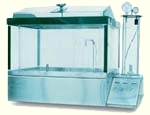Testing Disciplines
Salt Fog
| Salt is one of the
most pervasive chemical compound in the world. It is
found in the oceans, the atmosphere, ground surfaces,
lakes and rivers. In coastal regions, this exposure is
intensified and, in a marine environment the exposure
reaches maximum. As a consequence most equipment and
materiel will be exposed to some form of salt during its
life cycle. Salt fog tests are performed to determine the resistance of equipment or materials to the effects of an aqueous salt atmosphere. The effects of exposure of material to the salt environment can be divided into three broad categories: |
|
 |
|
| This test is typically
performed in a non-corrosive test chamber, at an elevated
temperature of approximately 90° F. The test unit is
suspended in an atmosphere of atomized salt solution for
a typical duration of from one to seven days.
The salt fog composition can be Sodium Chloride (NaCl) or synthetic seawater. The salt fog can be combined with Sulfur Dioxide to simulate acid rain or precipitate from combustion by products. |
|
| Testing is performed in accordance with Military, Commercial (ASTM) and Federal standards. | |
| Typical Test Specifications | |
HOW CAN WE HELP?
Whether you're looking for a standard test or have a unique testing problem,
we can help. We have the experience that you can rely on and the creativity
to solve your problem.



